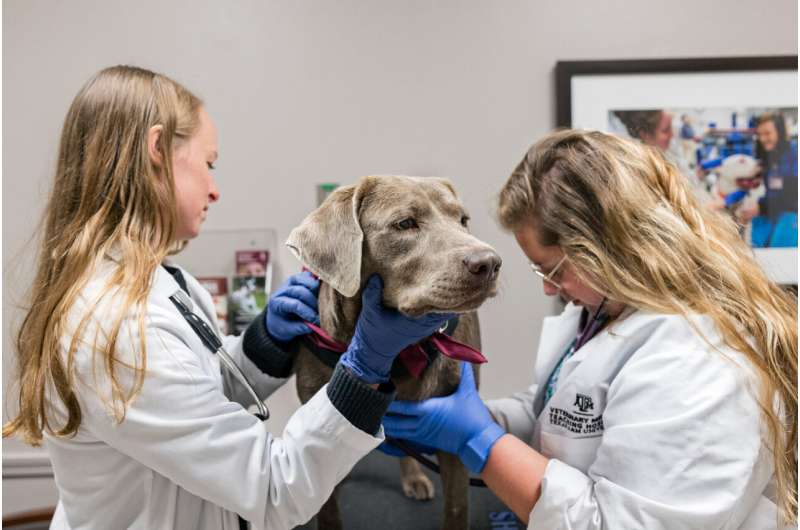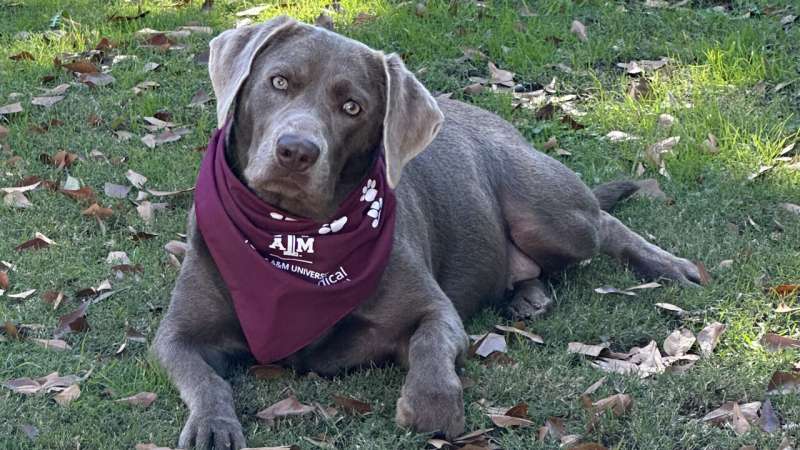This article has been reviewed according to Science X's editorial process and policies. Editors have highlighted the following attributes while ensuring the content's credibility:
fact-checked
trusted source
proofread
Veterinarians diagnose rare autoimmune disease, put dog on road to recovery

Having two autoimmune diseases is unusual for a dog, but having three is exceptionally rare.
When Lanie, an English silver Labrador retriever, began showing signs of another illness less than a year after the diagnosis of her first two autoimmune diseases, her owners acted quickly, taking her to their local, trusted emergency veterinary clinic.
The clinic used every tool at its disposal to help Lanie but ultimately determined that she needed more advanced diagnostic equipment than it could provide. The clinic recommended her owners, Anthony and Clara M. Simpson, take her to the Small Animal Teaching Hospital (SATH) at Texas A&M University.
While Lanie is now back to good health, thanks to the Internal Medicine and Soft Tissue Surgery teams at Texas A&M, the journey to diagnosing her mystery ailment took a few unexpected turns along the way.
A double diagnosis
The Simpsons' desire to bring a puppy into their family was sparked after work travel became more frequent for Anthony in 2022. After bringing Lanie home from her birthplace in Ardmore, Oklahoma, they bonded quickly with their silver pup and became a family of three.
"We can't imagine our lives without her now," Clara said. "There is nothing better than coming home to Lanie, who is always happy to see us and makes us smile, regardless of the kind of day we have had."
A month after bringing Lanie home, the couple noticed something was not quite right. Lanie was almost 3 months old, which meant she should have been an energetic puppy; instead, she was lethargic and uninterested in just about everything.
The Simpsons' pursuit of care for Lanie led them to Gulf Coast Veterinary Specialists (GCVS), a large emergency clinic in Houston. There, Lanie was diagnosed with Juvenile Cellulitis (puppy strangles)—a rare autoimmune disease that typically affects puppies up to 6 months of age—as well as Hypertrophic Osteodystrophy (HOD)—an auto-inflammatory disease of the bones.
"Dr. Rhonda Dixon, the doctor who treated Lanie at GCVS, is a Texas A&M alumna," Clara said. "She was incredible and diagnosed Lanie after just one day and said that having puppy strangles and HOD at the same time was a very rare thing. Even so, she reassured us that both issues were treatable, and we were able to bring Lanie home soon after."
Out of the frying pan, into the fire
With Lanie back in good health, the family of three settled back into their daily routines. For Lanie, this included gathering the neighbors' weekly newspapers on her daily walks, letting Clara dress her in new bandanas, playing fetch and Frisbee as much as possible, taking an occasional weekend road trip, and documenting her life on her Instagram account.
"Then Sept. 9, 2023, rolled around," Anthony said. "It was a Saturday afternoon, and Lanie would barely open her mouth. She always wants to eat, so we knew something was going on."
A trip to the local emergency clinic determined Lanie hadn't eaten something she shouldn't have, but that visit ultimately left the family with more questions than answers.
"That's when the emergency veterinarian said, 'Have you thought about Texas A&M?'" Clara recalled. "She let us know that Texas A&M has veterinarians who specialize in all the different parts and pieces of veterinary medicine. And she mentioned that no matter what they find, the vets at Texas A&M can direct her to the right people within the same facility."
The following morning, the Simpsons drove from their home in Houston to College Station.
"We walked in, and it wasn't scary or chaotic; it was actually pleasantly calm," Clara said. "We were greeted with a smile, and everyone we met with that afternoon was very kind and patient. As much as it pained us to leave her, there was no doubt we were leaving her in the best hands."
Solving a mystery
Lanie was initially seen by the SATH's Emergency & Critical Care Service before being referred to Dr. Jessica Herman, a resident on the Small Animal Internal Medicine service. Sunday evening, her neck and face began swelling and continued to do so throughout the week, which meant she needed a diagnosis and treatment plan sooner rather than later.
"It was up to us to try and establish the underlying cause of the swelling and fever she was experiencing," Herman said.
"The difficulty in this diagnosis lies in the location of her swelling, which was under the chin, where we have salivary glands, nerves, blood vessels, muscles, lymph nodes and more; it is a very busy area that participates in supporting and moving the head, chewing, swallowing, breathing and talking—or, in Lanie's case, barking. We had to figure out if her swelling was a tumor, an abscess, or a foreign body like a sock."
Herman's first move was to order a computerized tomography (CT) scan, which allowed her team to get an inside look at Lanie's neck and head in three dimensions. The CT helped identify where Lanie's swelling was located internally, and the team enlisted Small Animal Radiology's help to collect samples from the swollen tissues that were continuing to get bigger using an ultrasound-guided technique.
"While the microscopic evaluation of these samples showed inflammation, we could not tell if the inflammation was due to a bacterial infection," Herman said. "For that, we had to loop in our awesome Soft Tissue Surgery team."
From there, surgery resident Dr. Chanel Berns performed a surgical biopsy in the pursuit of answers to Lanie's mystery illness and rapid, severe swelling.
"When I performed the surgery, it was clear that her lymph nodes were the problem," Berns said. "They were swollen to about 7 centimeters, whereas, typically, lymph nodes are less than a few centimeters."
From the biopsy, Lanie's Internal Medicine team was able to diagnose and confirm her condition with senior clinician Dr. Genna Atiee as canine sterile steroid-responsive lymphadenitis.
"When we break down the words in her diagnosis, it's easier to understand how her experience with puppy strangles led to her third autoimmune disease," Berns said. "Sterile means there's no underlying infectious disease, so no bacteria or fungus. Steroid-responsive means that all the swelling she had would clear up with proper steroid treatment. And lymphadenitis just means swelling of the lymph nodes.

"So, in short, she had swelling that wasn't being caused by an ongoing infection but, rather, likely resulted from her experience with puppy strangles," Berns said. "Her body was trying to fix a problem that didn't exist and triggered a new autoimmune response."
Herman explained that sterile steroid-responsive lymphadenitis is similar, and may be related, to puppy strangles and that the two diseases often come together.
"Given her history of autoimmune diseases, it is safe to say that her immune system is not entirely normal," she said.
Lanie's veterinarians determined the best steroid treatment for her condition and began seeing a rapid reduction in her swelling after application.
"All three of the diseases Lanie has had in her lifetime are rare, but the sterile steroid-responsive lymphadenitis is very uncommon," Berns said. "Lanie's case was so dramatic because you could see from one day to the next how quickly she was either getting worse or better with her swelling.
"Thankfully, once we knew what we were treating, she had a very quick response to the treatment," she said. "We started to see results in reducing her swelling within days, and if you see her now, you'd never know she experienced an autoimmune disease, much less three."
Reuniting the family
After a week at the SATH, Lanie was able to return home, where she's finishing up her treatment and enjoying the life of a happy, healthy pup again.
"Thankfully, Lanie responded beautifully to the steroids we started and is living as a happy pup," Herman said. "However, some dogs will require multiple immunosuppressants to keep their disease in check. As we taper Lanie off her steroids, we hope to see her lymph nodes remain normal, but we are taking it very slow just in case."
In the meantime, Lanie is back to enjoying her evening walks to the neighborhood park, eating all of her favorite foods—especially fresh fruit—and sharing her journey with the world.
"I don't think that there will ever be enough words to tell her Texas A&M veterinary team how grateful we are," Clara said.
"I've always heard that you should take your pets to Texas A&M and to make sure that your vet is an Aggie veterinarian. And now that we've experienced their level of care and compassion, we get it—100%. We have seen firsthand how they treat the families and the animals under their care—they understand that they're more than pets; they're family."
Provided by Texas A&M University



















